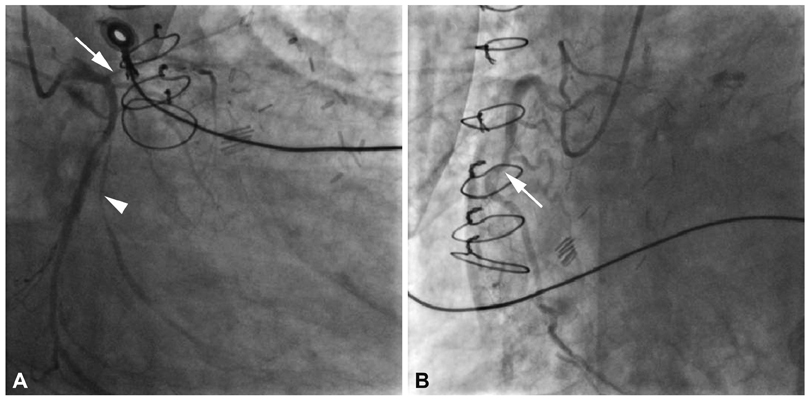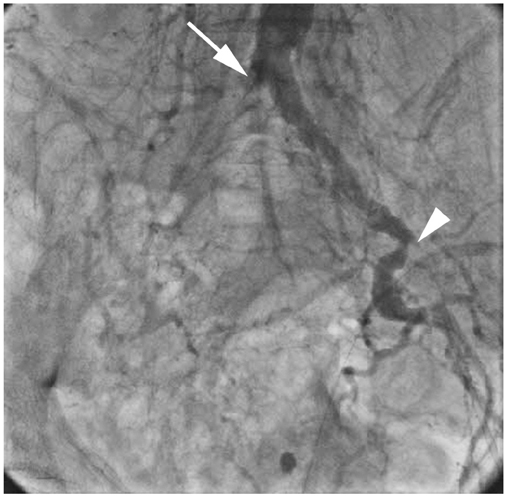Korean Circ J.
2012 Dec;42(12):866-868. 10.4070/kcj.2012.42.12.866.
Sudden Cardiac Arrest with Acute Myocardial Infarction Induced by Left Subclavian Artery Occlusion in a Patient with Prior Coronary Artery Bypass Surgery
- Affiliations
-
- 1Department of Cardiology, Myongji Hospital Cardiovascular Center, Kwandong University College of Medicine, Goyang, Korea. chodk123@paran.com
- KMID: 1491106
- DOI: http://doi.org/10.4070/kcj.2012.42.12.866
Abstract
- Multivascular preventive and therapeutic approaches are necessary in patients with coronary artery disease because atherosclerosis has a common systemic pathogenesis. We present a rare case of sudden cardiac arrest with acute myocardial infarction induced by the total occlusion of left subclavian artery (LSCA) in a patient with a history of previous coronary artery bypass surgery using the left internal mammary artery. We initially performed blind-puncture of left brachial artery, attempting percutaneous coronary intervention because pulses were absent in both upper and lower extremities. However, the cause of sudden cardiac arrest was atherosclerotic total occlusion of LSCA. The patient was stabilized after successful revascularization of LSCA by percutaneous transluminal angioplasty with stent insertion.
MeSH Terms
Figure
Reference
-
1. Shadman R, Criqui MH, Bundens WP, et al. Subclavian artery stenosis: prevalence, risk factors, and association with cardiovascular diseases. J Am Coll Cardiol. 2004. 44:618–623.2. Cherry KJ. Rutherford RB, editor. Atherosclerotic occlusive disease of brachiocephalic arteries. Vascular Surgery. 2000. 5th ed. Philadephia: W.B. Saunders Company;1140–1141.3. Arend WP, Michel BA, Bloch DA, et al. The American College of Rheumatology 1990 criteria for the classification of Takayasu arteritis. Arthritis Rheum. 1990. 33:1129–1134.4. Singer AJ, Hollander JE. Blood pressure. Assessment of interarm differences. Arch Intern Med. 1996. 156:2005–2008.5. Fairbairn JF, Juergens JL, Spittell JA. Peripheral Vascular Diseases. 1972. 4th ed. Philadelphia: W.B. Saunders Company.6. Kappert A. Lehrbuch und Atlas der Angiologie. 1987. 12th ed. Bern: Huber.7. Azzarone M, Cento M, Mazzei M, Tecchio T, Ugolotti U. Symptomatic subtotal occlusion of the innominate artery treated with balloon angioplasty and stenting. J Endovasc Ther. 2000. 7:161–164.8. Rodriguez-Lopez JA, Werner A, Martinez R, Torruella LJ, Ray LI, Diethrich EB. Stenting for atherosclerotic occlusive disease of the subclavian artery. Ann Vasc Surg. 1999. 13:254–260.9. Hadjipetrou P, Cox S, Piemonte T, Eisenhauer A. Percutaneous revascularization of atherosclerotic obstruction of aortic arch vessels. J Am Coll Cardiol. 1999. 33:1238–1245.
- Full Text Links
- Actions
-
Cited
- CITED
-
- Close
- Share
- Similar articles
-
- Acute Myocardial Infarction caused by Left Coronary Artery Aneurysm following Blunt Chest Trauma: A case report
- Myocardial Abscess with Coronary Artery Occlusion: One Case Report
- Coronary Artery Bypass Grafting in Patients with Acute Myocardial Infarction with an Abnormal Origin of the Right Coronary Artery
- A Case Report of a Huge Coronary Artery Aneurysm with Acute Myocardial Infarction
- Patent Coronary Artery Bypass Graft (CABG) is not Sufficient for Myocardial Perfusion: Non-ST Elevation Myocardial Infarction Caused by Critical Subclavian Artery Stenosis




